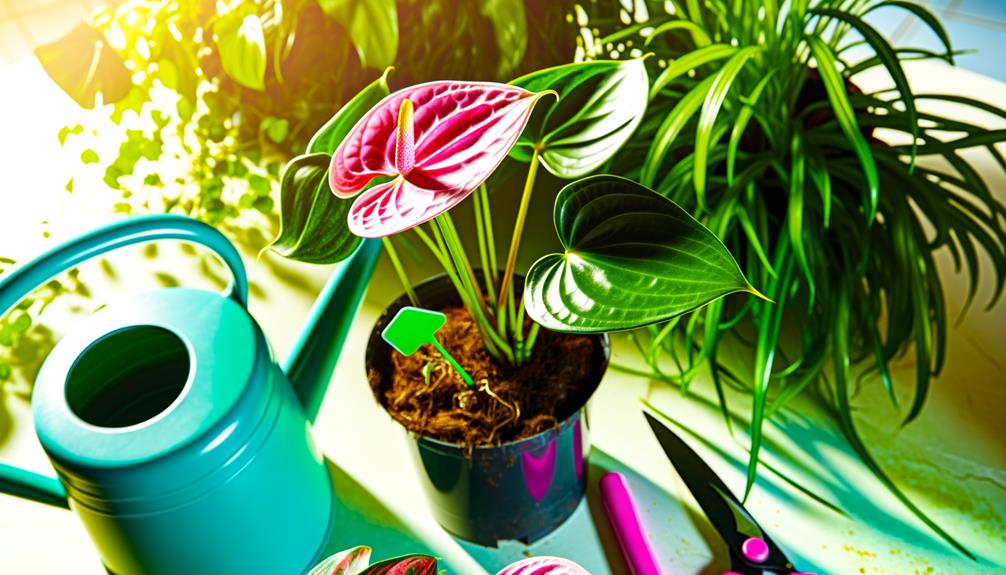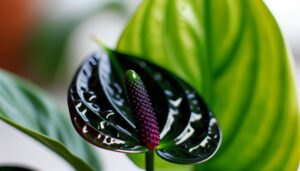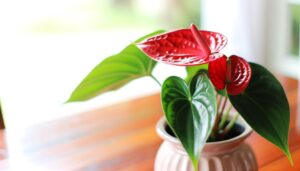How to Thrive With Anthurium Pink Explosion Plants: 10 Essential Tips
Thriving with Anthurium Pink Explosion plants demands precise care. Select a pot with appropriate drainage; terracotta enhances aeration, while plastic retains moisture.
Employ a substrate mix of orchid bark, perlite, peat moss, and activated charcoal. Maintain soil moisture without waterlogging, adjusting per environmental factors.
Provide bright, indirect sunlight and maintain temperatures of 65-80°F with 70-80% humidity. Fertilize bi-weekly in growing seasons using a balanced 20-20-20 N-P-K fertilizer at half strength.
Prune with sterilized tools during active growth, and monitor for pests through regular inspection. Repot every 1-2 years to support nutrient uptake.
Detailed techniques follow.

Key Takeaways
- Use a well-draining soil mix with orchid bark, perlite, peat moss, and activated charcoal.
- Water regularly to keep soil damp but avoid waterlogging.
- Provide bright, indirect sunlight for several hours daily.
- Maintain a temperature range of 65-80°F and humidity levels of 70-80%.
- Fertilize bi-weekly in spring and summer using a diluted 20-20-20 N-P-K ratio fertilizer.
Choose the Right Pot
Choosing a suitable pot for Anthurium Pink Explosion plants is necessary to guarantee peak root health and overall plant growth. The pot should have adequate drainage holes to prevent waterlogging, which can lead to root rot. An ideal pot size facilitates balanced root expansion; typically, a container with a diameter 1-2 inches larger than the root ball is recommended.
Material selection is essential—terracotta pots are porous and allow for better aeration, while plastic pots retain moisture longer. Ensuring the pot's depth accommodates the plant's vertical root growth is important. Additionally, repotting every 1-2 years prevents root-bound conditions, promoting nutrient uptake efficiency.
These factors collectively sustain the Anthurium's robust health and flourishing development.
Ideal Soil Mix
To ensure the best growth and health of Anthurium Pink Explosion plants, selecting a suitable soil mix that offers excellent drainage and aeration is essential. An ideal soil mix prevents root rot and guarantees nutrient availability. A scientifically balanced mix should comprise the following components:
- Orchid Bark: Provides ample drainage and mimics the plant's natural epiphytic environment.
- Perlite: Enhances aeration by preventing soil compaction, vital for root health.
- Peat Moss: Retains moisture without waterlogging, offering a consistent water supply.
- Activated Charcoal: Maintains soil freshness by absorbing impurities and toxins.
Combining these elements creates a porous, nutrient-rich medium, facilitating strong growth and vibrant foliage. Proper soil composition is fundamental to thriving Anthurium Pink Explosion plants.
Watering Schedule
Establishing an ideal watering schedule for Anthurium Pink Explosion plants is essential for maintaining ideal soil moisture levels. This should be consistently damp but not waterlogged.
Monitoring soil moisture with a hygrometer can help prevent the risks associated with overwatering, such as root rot.
It is recommended to water when the top inch of soil feels dry to the touch. This ensures balanced hydration without saturation.
Optimal Watering Frequency
Maintaining an ideal watering frequency for Anthurium Pink Explosion plants is crucial for their health, as it directly impacts root aeration, nutrient uptake, and overall plant vigor. Best watering practices involve striking a balance to prevent both dehydration and waterlogging.
To achieve this, consider the following guidelines:
- Seasonal Adjustment: Increase watering during the growing season (spring and summer) and decrease it in the dormant period (fall and winter).
- Water Quality: Use distilled or rainwater to avoid chlorine and fluoride, which can harm the plant.
- Temperature Sensitivity: Water with room-temperature water to avoid shocking the roots.
- Frequency Monitoring: Water when the top 1-2 inches of soil are dry, typically every 7-10 days, adjusting based on environmental conditions.
These steps ensure the Anthurium Pink Explosion thrives effectively.
Soil Moisture Levels
Understanding soil moisture levels is essential for developing an effective watering schedule for Anthurium Pink Explosion plants.
These tropical perennials require a substrate that retains sufficient moisture without becoming waterlogged. Utilizing a high-quality, well-draining potting mix combining peat, pine bark, and perlite guarantees optimal aeration and moisture retention.
Use a soil moisture meter to monitor hydration levels accurately; aiming for a consistently moist, but not saturated environment. The ideal range is typically between 40-60% soil moisture content.
Additionally, make sure that the top inch of soil dries out slightly between waterings. This balance is vital, as excessive dryness can lead to root desiccation, while excessive moisture can hinder root oxygenation, negatively impacting plant health and vigor.
Avoid Overwatering Risks
Implementing a precise watering schedule is crucial to mitigate the risks associated with overwatering Anthurium Pink Explosion plants. Overwatering can lead to root rot, nutrient deficiency, and fungal infections, which compromise plant health. To avoid such pitfalls, adhere to the following guidelines:
- Soil Moisture Monitoring: Employ a moisture meter to make sure the soil is consistently moist but not waterlogged.
- Watering Frequency: Generally, water once a week, adjusting based on environmental conditions like humidity and temperature.
- Drainage Assurance: Utilize well-draining potting mix and guarantee pots have adequate drainage holes to prevent water stagnation.
- Seasonal Adjustments: Reduce watering frequency during the dormant winter months when the plant's metabolic activities slow down.
Following these steps can greatly improve plant health and longevity.
Light Requirements
Ideal growth of Anthurium Pink Explosion plants necessitates exposure to bright, indirect sunlight for several hours each day. Direct sunlight can cause photodamage, leading to leaf scorch and reduced chlorophyll production. Instead, place the plant near east or north-facing windows where it can receive diffused light.
Plants positioned in low-light conditions may exhibit etiolation, characterized by elongated stems and diminished leaf coloration. The use of artificial light sources, such as full-spectrum fluorescent or LED grow lights, can supplement natural light, ensuring photosynthetic efficiency.
Maintain a consistent photoperiod of 10-12 hours daily to mimic natural tropical environments. Monitoring light intensity with a lux meter, aiming for 10,000-20,000 lux, will optimize photosynthetic activity and overall plant health.
Humidity Levels
Maintaining ideal moisture levels is crucial for the health and vibrancy of Anthurium Pink Explosion plants. These tropical perennials thrive best in environments mimicking their native habitats, which entails high moisture levels, ideally between 70-80%.
Insufficient moisture can lead to desiccation of the leaves and impaired overall growth.
To ensure peak moisture, consider the following strategies:
- Humidifiers: Utilize an ultrasonic humidifier to maintain consistent moisture levels.
- Misting: Regularly mist the foliage with distilled water to enhance ambient moisture.
- Pebble Trays: Place the plant pot on a tray filled with water and pebbles to increase moisture through evaporation.
- Grouping Plants: Cluster multiple plants together to create a microenvironment with higher moisture levels.
These measures will help mitigate the risk of subpar moisture conditions.
Temperature Range
For best development, Anthurium Pink Explosion plants require a temperature range between 65-80°F, closely resembling their native tropical climates. Maintaining this temperature range is essential to optimize physiological processes such as photosynthesis, transpiration, and nutrient uptake. Subpar temperatures can hinder cellular activities, leading to stunted growth or increased susceptibility to diseases.
Moreover, temperatures below 60°F may induce chilling injury, compromising the plant's foliage integrity. Conversely, prolonged exposure to temperatures exceeding 85°F may result in thermal stress, causing leaf scorching and reduced vigor.
Consistent monitoring of ambient temperatures guarantees adherence to these ideal conditions. Using thermometers and climate control systems can assist in maintaining a stable microenvironment, thereby fostering vigorous growth and vibrant blooms in Anthurium Pink Explosion plants.
Fertilization Tips
Proper fertilization is essential for the robust growth and flowering of Anthurium Pink Explosion plants, necessitating a balanced nutrient regimen tailored to their specific physiological needs. To achieve ideal outcomes, consider the following guidelines:
- Nutrient Ratio: Utilize a balanced fertilizer with an N-P-K ratio of 20-20-20 to ensure an even supply of nitrogen, phosphorus, and potassium.
- Frequency: Fertilize bi-weekly during the growing season (spring and summer) and reduce to monthly applications in fall and winter.
- Dilution: Dilute the fertilizer to half the recommended strength to prevent root burn and nutrient toxicity.
- Application Method: Apply the fertilizer evenly across the soil surface, avoiding direct contact with the plant's stems and leaves to prevent chemical burns.
These practices will support vigorous growth and vibrant blooms.
Pruning Techniques
Effective pruning techniques are critical for promoting best growth and maintaining the health of Anthurium Pink Explosion plants.
The timing of pruning, ideally during the plant's active growth phase, helps minimize stress and maximizes recovery.
Utilizing sterilized, sharp pruning tools is essential to prevent pathogen transmission and guarantee clean cuts, thereby enhancing the plant's vigor and aesthetic appeal.
Timing for Optimal Growth
Achieving peak growth in Anthurium Pink Explosion plants requires precise timing and techniques in pruning to enhance both floral and vegetative vigor. Ideal pruning times are crucial to the plant's health and productivity. Following these guidelines ensures maximal growth:
- Early Spring: Prune to stimulate new growth cycles. This period aligns with the plant's natural growth phase.
- Post-bloom: After flowering, removing spent blooms redirects energy to root and leaf development.
- Mid-summer: Light pruning controls size and prevents legginess while maintaining photosynthetic efficiency.
- Dormant Phase: Minimal pruning during dormancy prevents undue stress and conserves energy reserves.
Tools and Safety Tips
To perform precise pruning and safeguard the optimal health of your Anthurium Pink Explosion plants, utilizing the correct tools and following safety protocols is crucial. Employ sterilized, sharp pruning shears to prevent tissue damage and pathogen transmission. Clean tools with rubbing alcohol before and after use. Wear gloves to shield against irritants in the plant's sap. Cut just above a node to promote new growth while eliminating dead or damaged leaves.
| Tool | Purpose |
|---|---|
| Sterilized Shears | Clean cuts, minimize infections |
| Rubbing Alcohol | Disinfect tools |
| Protective Gloves | Safeguard against skin irritation |
Following these guidelines ensures the strength and aesthetic appeal of your Anthurium Pink Explosion plants.
Pest Control
Maintaining the health of Anthurium Pink Explosion plants necessitates vigilant pest control strategies to prevent infestations by common pests such as aphids, spider mites, and mealybugs. Effective pest management involves both preventive and reactive measures.
Regularly inspect plant surfaces for signs of pests, such as discolored leaves or webbing, and implement the following steps:
- Isolation: Isolate affected plants immediately to prevent the spread to healthy plants.
- Manual Removal: Remove visible pests using a soft cloth or gentle stream of water.
- Insecticidal Soap: Apply insecticidal soap or neem oil, ensuring thorough coverage of all plant surfaces.
- Biological Control: Introduce natural predators like ladybugs or predatory mites to control pest populations.
Consistent monitoring and timely intervention are key to maintaining pest-free Anthurium Pink Explosion plants.
Repotting Guidance
Effective repotting of Anthurium Pink Explosion plants requires careful attention to pot selection, soil composition, and drainage efficiency.
Utilize a pot with sufficient drainage holes to prevent waterlogging, which can lead to root rot.
Opt for a well-aerated, peat-based soil mix enhanced with perlite or orchid bark to ensure peak root health and nutrient uptake.
Choosing the Right Pot
Selecting a suitable container for Anthurium Pink Explosion plants involves considering factors such as drainage, material composition, and size to guarantee root health and growth. A meticulously chosen container ensures the plant's physiological needs are met efficiently.
Key considerations include:
- Drainage: Make sure the container has sufficient drainage holes to prevent waterlogging and root rot.
- Material: Opt for breathable materials like terracotta to improve aeration and reduce excess moisture retention.
- Size: Choose a container slightly larger than the current root ball to allow for gradual expansion without overwhelming the plant.
- Shape: A deeper container facilitates root development, while a broader base provides stability for the plant.
Soil and Drainage
Ensuring ideal soil composition and efficient drainage is essential for the health and growth of Anthurium Pink Explosion plants during the repotting process. A well-aerated, organic-rich substrate is necessary. Use a mix comprising 50% orchid bark, 30% peat moss, and 20% perlite to provide optimal aeration and moisture retention.
This blend mimics the plant's natural epiphytic environment, allowing roots to breathe while avoiding waterlogging. Implementing a pot with drainage holes is necessary to prevent root rot. During repotting, gently loosen the root ball and remove any decayed roots.
Position the plant centrally in the new pot, ensuring roots are adequately spread. Water thoroughly post-repotting to settle the soil and eliminate air pockets, promoting strong root establishment.
Conclusion
Thriving with Anthurium 'Pink Explosion' plants requires adherence to precise horticultural practices. When these plants are cultivated under ideal conditions—much like a finely-tuned orchestra producing harmonious symphonies—the result is a vibrant display of pink blooms.
Empirical evidence suggests that consistent humidity levels above 60% enhance foliage vitality to a great extent. Therefore, the meticulous balance of water, light, and nutrients forms the cornerstone of successful cultivation, ensuring these botanical specimens flourish splendidly.






